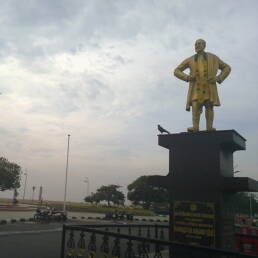This painting below has been a subject of much debate over the past two centuries and if some of the facts are correct, it depicts an intriguing connection between India and one of the most celebrated authors of all time.
Born in 1723 in Devon in England, Joshua Reynolds was attracted to the art of drawing at a very early age. As the years went by Reynolds established himself as one of the finest painters in the mid-18th century eventually founding the Royal Academy of Arts.
One particular painting of Reynolds however draws special attention. Hanging in the Gemäldegalerie in central Berlin and titled “George Clive and his Family with an Indian Maid”, the painting with its exquisite brushwork is intriguing for more reasons than one.
The date of the painting is obscure; it first surfaced among the collections of one Sir Alexander Thomson, in the early 19th century, when it was simply known as “A Family group, with Black Servant”.
By the 1830s it had undergone a significant name change, it was then assumed that it was a portrayal of the Lord and Lady Clive, one of their daughters and a Hindoo nurse, Lord Clive being the infamous Robert Clive himself.
But that identification didn’t stay for long; it was later claimed that the picture portrayed a different Clive, cousin of Robert, George Clive, and his family, but even this identity came to be questioned a century later in the 1960s when details of George’s whereabouts at the time came to be known.
Now, this is where it gets interesting, it was argued that the actual family in the picture was a certain Tysoe Hancock, his wife Philadelphia Austen, their daughter Eliza and their maid. The family was believed to have good ties with Reynolds when he drew this picture.
Hancock, a native of Kent joined the East India Company as a man of medicine and sailed to Calcutta in the early 1750s where he became close friends with Warren Hastings, who would, later on, go on to become the first governor-general of British-controlled India.
A couple of years later Hancock met Philadelphia, the sister of Reverend George Austen who was at the time on a husband’s hunting trip in India. Philadelphia was looking to marry someone in power and wealth and though the age gap between her and Hancock was huge, they got married in 1753.
Soon after, a daughter was born named Eliza, though it is debated that she came not from the wedlock of Hancock and Philadelphia but from an affair between Philadelphia and Hastings. The affair, however, didn’t seem to cause any damage to Hancock’s and Hastings’s friendship.
The Hancock family travelled back to England in 1765 with one of their maids Clarinda and it was at that time that they came in contact with Reynolds to draw a family portrait. It is believed to have been a series of paintings which was later sold as “The family group, with black servent”.
The whereabouts of that series of pictures by Reynolds were unknown for a while. Tysoe Hancock returned to India to make a fortune again but succumbed to a bout of malaria and was buried in Calcutta. The story however doesn’t end here.
Some of Eliza’s and her mother’s exotic and exuberant adventures were later captured in words by her famous cousin Jane Austin. Jane was 8 years old when a 20-year-old Eliza barged into her life and awed her with her magnetic presence and beauty.
During her stay in Paris with her mother, Eliza would often write to her cousins providing vivid descriptions of the many sights and scenes of Paris, of the plays, and of the parties. After her mother’s death, Eliza moved to London where her hand was asked in marriage by Jane’s brothers.
First by Jane’s eldest James who she refused and then by another brother Henry. Jane would often visit Eliza as she would throw parties reminiscing of her days in Paris. Eliza’s life was, however, cut short as she died at the age of 51, from breast cancer with Henry and Jane by her side.
Eliza’s magnetic personality is supposed to have inspired the character of Mary Crawford in Jane Austin’s novel, Mansfield Park, published in 1814, a year after Eliza’s death.
Sources:
Hitherto unrecognized picture of Tysoe Saul Hancock, Philadelphia Austen, Eliza Hancock, & Clarinda, Indian maid, Ellen Moody, https://reveriesunderthesignofausten.wordpress.com/2017/07/24/hitherto-unrecognized-picture-of-tysoe-saul-hancock-philadelphia-austen-eliza-hancock-clarinda-indian-maid/




